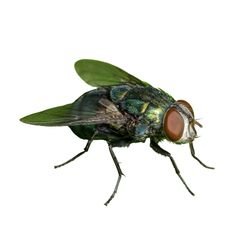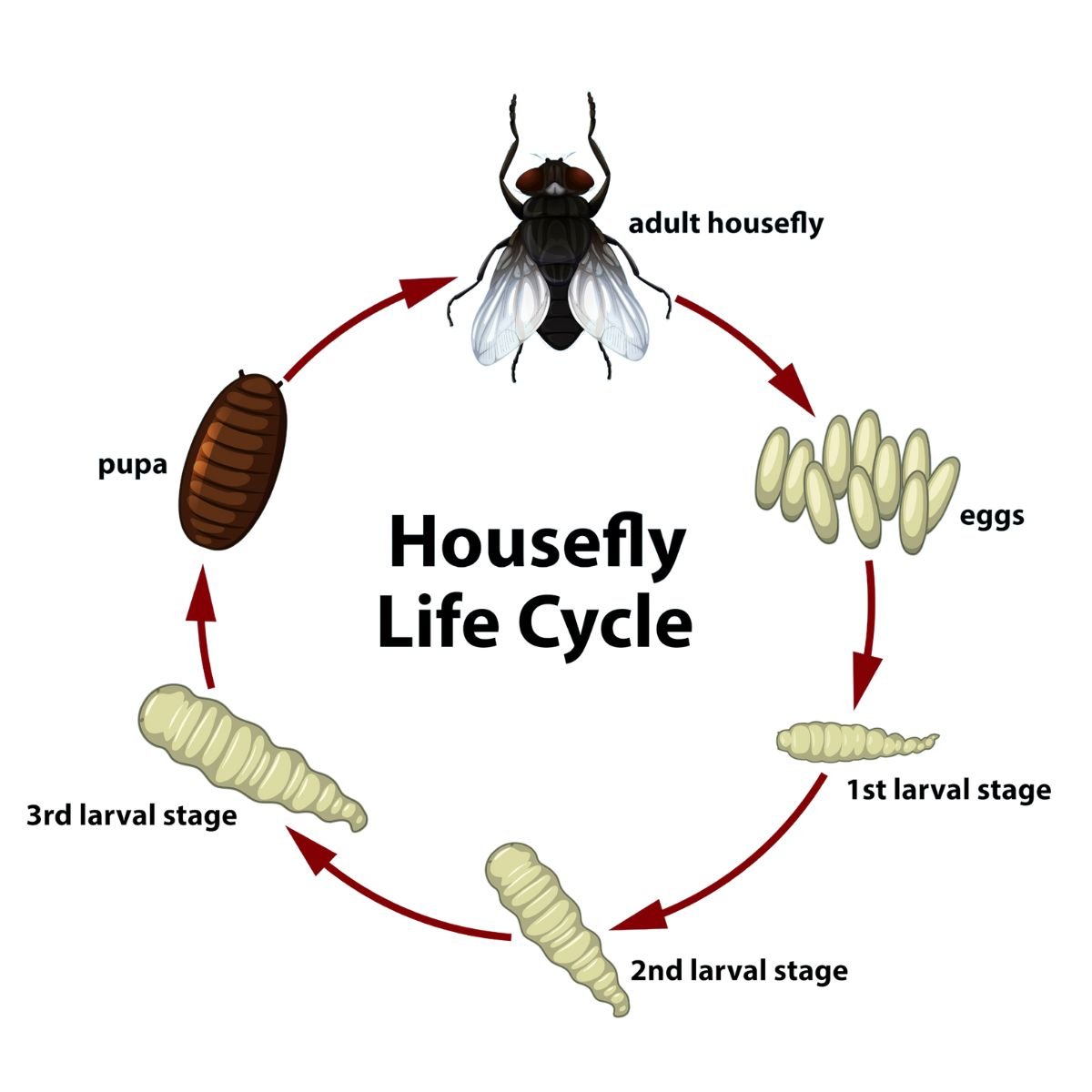Flies

Flies Identification
Flies are grey in color with four dark stripes on their thorax.
Flies are typically about 6-7 mm in length.
Flies have slender bodies, two wings, and a pair of halteres that help them maintain balance during flight.
Get A Free Quote
We are affordable Pest Control Service in GTA & Surroundings Areas.
What are Flies
Flies are insects that belong to the order Diptera, which means “two wings.” They are known for their quick and erratic flying habits, which allow them to avoid predators and fly away from danger.
Interestingly, flies play a crucial role in nature by facilitating pollination and decomposing organic matter into nutrients that plants can utilize. However, their infestation can cause severe health issues. Let’s understand flies’ behavior, habitat, and how we can prevent them.
Physical Description
As their name suggests, they have two wings and a pair of large compound eyes. Flies also have antennae and mouthparts adapted for piercing or sucking, depending on the species. Flies are generally attracted to areas with decaying organic matter, such as garbage, animal feces, or dead animals.
Flies Behaviour
Flies are one of Canada’s most common and widely distributed insects. They are small, annoying, and pesky creatures that can be nuisances in your home. They have two wings that beat up to 200 times per second, allowing them to hover in place or move quickly through the air. Flies use their proboscis (a long, straw-like tongue) to suck up fluids from various sources.
Flies Habitat
Flies can be found in almost every habitat on Earth. They can be found in forests, fields, cities, and rural areas. They are often found in areas with moist and decaying matter, such as compost piles, garbage cans, and animal feces.
Some species of flies, such as horse flies, prefer open grassy areas, while others, such as fruit flies, are commonly found in kitchens and food storage areas. If you are facing fly issues in your neighborhood then get in touch with flies control toronto.
If you are also facing a fly issue in your neighborhood, call Acme Pest Solutions for flies, mosquitoes, ants, and other pest control in Toronto!
What do Flies Eat?
Flies are omnivorous, which means they feed on both plants and animals. Some species of flies feed on nectar, pollen, and plant sap, while others feed on decaying matter, including dead animals and plant material. House flies, for example, feed on a variety of food sources, including animal feces, garbage, and rotting food. Fruit flies, on the other hand, feed on ripe or decaying fruits and vegetables.
Our Guarantee
Acme Pest Solutions is dedicated to providing exceptional pest control services focusing on customer satisfaction. We aim to exceed industry standards by delivering high-quality work. We stand behind our work with a guarantee for each job completed, giving customers peace of mind. We are committed to ensuring seamless and high-quality service and will return to make things right if any issues arise.
Flies Lifecycle
The life cycle of a fly begins when the female lays eggs, which hatch into larvae, also known as maggots. The larvae feed on decaying matter, growing and developing over several days or weeks. Once fully developed, the larvae will pupate, transforming into adult flies.
The life cycle length varies depending on the species of fly and environmental conditions, but it typically takes a few days to several weeks.

Common Types of Flies
The following two types of flies are most commonly found in Ontario:
Crane Flies
Crane flies are commonly known as daddy longlegs or mosquito hawks, but they are not actual mosquitoes or spiders. Crane flies have slender bodies and extremely long legs that appear distinct. They are brown or grayish-brown and can range in size from 15 mm to 25 mm long.
- Diet: As adults, crane flies do not eat at all, as they do not have functional mouthparts. Instead, they focus on mating and reproducing. However, in their larval stage, crane flies are herbivorous, feeding on roots, leaves, and other vegetation. They play an important role in ecosystems by helping to break down plant matter and recycle nutrients.
- Habitat: Crane flies can be found in various habitats, such as forests, wetlands, meadows, and gardens. Adult crane flies feed on nectar from flowers, while their larvae feed on roots or decomposing organic matter. In some cases, their larvae may cause damage to lawns and crops by feeding on the grass roots.
- Lifecycle: The lifecycle of a crane fly can vary depending on the species and environmental conditions. In general, crane flies begin their lives as eggs laid in moist soil or water. The eggs hatch into larvae, which look like tiny worms and feed on plant matter. The larvae then pupate, transforming into the adult crane fly we see flying around.
Drain Flies
Drain flies, also known as moth flies, are small insects often found near drains, sewers, and other damp environments. These small flies are usually gray or brown in color and typically measure about 1/8 inch in length.
- Behavior: Drain flies are typically nocturnal insects, meaning they are most active at night. They are not strong fliers and tend to move around in short, erratic flights. They are attracted to light and can often be seen flying around light fixtures or windows. Drain flies are not harmful to humans and do not bite or sting.
- Habitat: Drain flies are primarily found in areas with high moisture levels. This can include kitchens, bathrooms, and other areas with standing water or damp conditions. They are often located near drains, pipes, and other places where water can accumulate. In Canada, they are most commonly found in residential and commercial buildings, but can also be found outdoors in areas such as swamps, wetlands, and other damp environments.
- Lifecycle: Drain flies have a unique lifecycle that involves four stages: egg, larva, pupa, and adult. The female drain fly can lay up to 100 eggs at a time, usually near the surface of standing water or moist surfaces. The eggs hatch into larvae, which are small, worm-like creatures that feed on organic matter and bacteria found in damp environments. The larvae then spin cocoons and enter the pupal stage, undergoing metamorphosis and developing into adults.
How to Prevent Flies' Infestation?
- Keep your home clean and organized. This will make it easier to keep flies away.
- Use a fly repellent. This will help keep flies away from your home and off your food.
- Seal up any openings that flies can get into. This includes cracks in your home’s walls, windows, and ventilation systems.
- Remove any food or garbage that may be attracting flies. This includes anything that’s rotting or covered in flies.
- Keep your home well-lit. This will make it easier to see and catch flies.
- Keep your pets locked up when they’re not supervised. This will help keep them out of flies and other pests.
- Use a barrier treatment. A barrier treatment is one of the best ways to prevent crane fly infestations.
When to Call a Professional
Flies are notoriously difficult to eliminate once they have infested an area. This is because their eggs are often laid in hard-to-reach places where traditional cleaning methods may need to be more effective. If you’re dealing with a serious fly problem, please don’t hesitate to contact ACME Pest Solutions.
Other Pest Problems We Treat in the GTA
Our team of experts can help you eliminate the following pests:
Also some other common pests like ants, mosquitos etc.
Frequently Asked Questions (Faqs)
Flies are known to spread diseases by picking up pathogens from contaminated surfaces, such as feces or decaying matter, and then transferring them to humans through contact with food, drinks, or open wounds.
Drain flies can damage plumbing systems over time. When drain fly larvae feed on organic matter such as hair and grease buildup in pipes, it can lead to clogs and backups that require costly repairs.
They can carry numerous pathogens on their bodies, including bacteria, viruses, protozoa, and helminths. They spread typhoid fever, cholera, dysentery, and salmonellosis.
The entire lifecycle of a drain fly can take anywhere from 8 to 24 days, depending on environmental conditions such as temperature and humidity.
The lifespan of an adult crane fly is relatively short, usually lasting only a few days to a few weeks.
